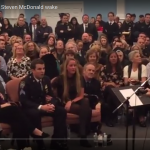The following column was written by Jerry Costello:
It’s been 70 long years since the Four Chaplains made their immortal sacrifice in the icy waters of the North Atlantic, and it will be 70 more years–and then some–before their heroic act is even in danger of being forgotten. As a crowd of several hundred proved recently in a northern New Jersey town, enough good people are determined to keep their memory alive. And so they should. The story of the Four Chaplains is one of the most stirring to emerge from the annals of World War II, and one of the most unbelievable, too. Yet it really happened.
Night had fallen on Feb. 3, 1943, at the height of the war, and the U.S.S. Dorchester, a troop ship that was part of an Allied convoy, was ferrying 902 GIs to a U.S. base in Greenland. Then it was hit by a German U-boat’s torpedo, and before long the Dorchester was sinking. Tragically, there were not enough lifejackets on board, but the chaplains assigned to the ship did their part. The four–a Catholic priest, a rabbi, and two ministers–heroically gave up their own lifejackets to struggling GIs, and went down with the ship. Only 230 troops survived. Six-hundred seventy two–including the Four Chaplains–lost their lives.
The four were remembered Feb. 3, 2013, the 70th anniversary of the Dorchester’s sinking, at a Mass in St. Stephen’s Church in Kearny, N.J., the last parish served by the priest–Father John P. Washington, a native of Newark.
“Father Washington and his companions did not wake up on Feb. 3, 1943, and decide that they were going to be heroes,” said Archbishop Timothy P. Broglio, head of the U.S. Archdiocese for the Military Services. “They were men for others with the courage of their convictions long before that day dawned.”
Archbishop Broglio celebrated the Mass, and officiated at the unveiling of a 16-foot high statue of Father Washington and his fellow chaplains: Rabbi Alexander D. Goode, the Rev. George L. Fox, a Methodist minister, and the Rev. Clark V. Poling, a Dutch Reformed minister.
Michael C. Gabriele, who covered the event for Catholic News Service, wrote: “Survivors reported seeing the four men gathered in prayer on the deck of the listing ship, their arms around each other, as it slipped into the water, according to historical records. The four men stayed calm amid the mayhem.”
The era was one in which cooperation between clergymen of different faiths was not nearly as common as it is today, and for years the action of the Four Chaplains, in Gabriele’s words, “resonated not just as an inspirational act of valor in war, but as a supreme demonstration of interfaith unity and compassion. It was a moment when four men from different religious backgrounds joined together as a single, brave quartet and answered the ultimate call of faith, sacrificing their own lives to save others.”
World War II produced many stories of heroism, both individual acts and sacrifices made by many. Few matched the dramatic impact of the story of the Four Chaplains, men who are inexorably bound to each other by ties of faith, sacrifice, and incredible courage. The dedication of a statue in their memory will ensure that a new generation of Americans will continue to be inspired by the heroism they showed so long ago.











